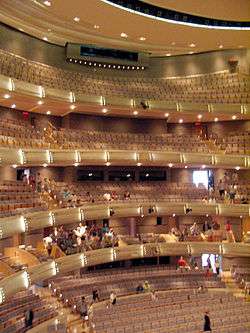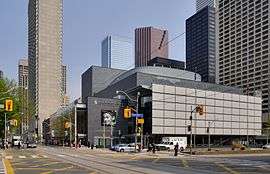Four Seasons Centre
|
Four Seasons Centre seen from University Avenue with sun shades covering its glazed facade | |
| Location |
145 Queen Street West Toronto, Ontario, Canada M5H 4G1 |
|---|---|
| Coordinates | 43°39′02″N 79°23′08″W / 43.65056°N 79.38556°WCoordinates: 43°39′02″N 79°23′08″W / 43.65056°N 79.38556°W |
| Owner | Canadian Opera House Corporation |
| Type | Opera house |
| Capacity | 2,071 |
| Construction | |
| Opened | 14 June 2006 |
| Architect | Diamond+Schmitt |
| Tenants | |
|
Canadian Opera Company National Ballet of Canada | |
| Website | |
| Four Seasons Centre | |
The Four Seasons Centre for the Performing Arts is a 2,071-seat theatre in Toronto, Ontario, Canada, located at the southeast corner of University Avenue and Queen Street West, across from Osgoode Hall. The land on which it is located was a gift from the Government of Ontario. It is the home of the Canadian Opera Company (COC) and the National Ballet of Canada.[1] The building's modernist design by was created by Canadian company Diamond and Schmitt Architects, headed by Jack Diamond. It was completed in 2006. The design includes an unusual glass staircase.[2]
History
In the 1980s the Canadian Opera Company and Financier Hal Jackman, president of the Ballet Opera House Corporation, had begun lobbying for a new building to replace the Sony Centre for the Performing Arts (earlier named the Hummingbird Centre and O'Keefe Centre). This building had housed the the opera company for about 40 years. The company had also previously been housed in the Royal Alexandra Theatre on King Street and the Elgin Theatre on Yonge Street.[3] Earlier in the city's history, the Grand Opera House stood at Bay and Adelaide until it was demolished in 1927.
Bay St proposal
In 1984, Ontario premier Bill Davis promised that a piece of provincial-owned land at Bay Street and Wellesley Street would be the home for the new opera house. The lot was estimated to be worth some $75 million.[4]
A design competition was won by the postmodern project of Moshe Safdie.[5] In 1988, the project was approved and the existing stores and government offices on the site were demolished.
After a new NDP provincial government under Bob Rae was elected in 1990, inheriting a large deficity because of a recession, the $311 million project was deemed excessively costly. The province was also dealing with the unexpectedly high $550 million cost of the SkyDome project. When the Opera House corporation refused to modify the design to lower costs, the government withdrew its funding commitment two months after the election.[6] In 1992, the province cancelled the project and the land was sold to developers. Two towers in the "Opera Place" development have been built on Bay Street, but as of June 2011 the rest of the property remains vacant.
University Avenue project
In 1997, the province allocated a parking lot, which previously housed offices for the Supreme Court of Ontario at Queen and University, for the project. The lot was valued at C$31 million, and the federal and provincial governments also pledged funding for a new more modest project that would cost about $130 million. The original plan called for a 190 m (620 ft) tower of offices and condominiums to be built by Olympia and York which would help fund the project. It would be further supplemented by a $20 million donation by Christopher Ondaatje. However, both Olympia and York and Ondaatje developed concerns about the project and withdrew. More importantly, the municipal government of Mel Lastman refused to provide any municipal funding.[7] The project collapsed again in 2000.
In 2002 the opera company under Richard Bradshaw issued an invitation in 2002 for designs. The company had secured a $20 million donation from the Four Seasons hotel chain in exchange for perpetual naming rights to the complex.
Ten architectural firms submitted proposals and the modernist design by Canadian company Diamond and Schmitt Architects, headed by Jack Diamond, was selected.
The complex took three years to construct at an estimated cost of $181 million. To provide wheelchair accessibilitym elevator access to the concourse level of Osgoode subway station was integrated into the construction of the Centre.[8] The Centre had its grand opening on 14 June 2006, with regularly scheduled performances commencing on 12 September 2006 with the inaugural production in the new opera house being Richard Wagner's epic tetralogy Der Ring des Nibelungen (The Ring of the Nibelung). Governor General Michaëlle Jean and other prominent Canadians attended the event. Three complete Ring Cycles were performed in September 2006.
R. Fraser Elliott Hall design

The five-tiered, horseshoe-shaped auditorium was modelled after European opera houses. Collaborating with Diamond Schmitt, New York-based theatre planning and design specialists Fisher Dachs Associates [9] arranged the room’s geometry and seating configuration to bring each of the 2,000 seats, including tiered balconies, as close to the stage as possible while maintaining an unobstructed view.[10][11]
The acoustics were designed by Bob Essert of Sound Space Design[12] and a team that included Aercoustics Engineering,[13] Wilson Ihrig & Associates[14] and Engineering Harmonics.[15] The undulating back walls of the venue, which diffuse the sound throughout the auditorium by reflecting the sound waves back to the stage, account for about 90 percent of the audible sound for the audience. To prevent audience members from detecting specific sounds and vibrations including traffic noise, the rumble from the adjacent subway line and streetcar line, and even the sirens of the emergency vehicles rushing to the nearby hospitals, the theatre sits on 489 rubber insulating pads.[16][17]
Other design elements reflect historic performance halls, including the Roman Amphitheatre.
Exterior
The hall was constructed on a limited budget, using contrasting materials. The City Room glass walls, curtain walls held by steel fixtures, look out on University Ave and Queen Street. The east, south and north sides are clad in dark brick. Windows on the north side have a view of Osgoode Hall, but the exterior on that side is unadorned. [18]
On the west is the sidewalk extension City Room, which is transparent and which illuminates the street. The solid, massive eastern facade broken only by horizontal windows, in contrast, blends into its office building and brick surroundings, towards York Street. John Bentley Mays states in his 2006 Canadian Architect article that East wall is “unresponsive to the need of vitality on the street.” The southern, Richmond Street facade, also plain brick, is opposite the Hilton Hotel. Architect Diamond defends his rather plain design, stating, "You do not make a city out of iconic pieces".[19]
Operatic and other production history
Outside of the standard repertory, some of the less-often performed, new works, or national premieres performed by the Canadian Opera Company include:
- 2006: First Canadian production of Richard Wagner's Der Ring Des Nibelungen
- 2007: Lady Macbeth
- 2008: From the House of the Dead
- 2010: Maria Stuarda
- 2011: Iphigenia in Tauris
- 2012: Love From Afar
- 2012: A Florentine Tragedy/Gianni Schicchi
- 2012: Semele
Dancap Productions has also given presentations of musicals at the Four Seasons Centre, including:
- 2010: Miss Saigon
- 2010: South Pacific
- 2011: Next to Normal
- 2011: Colm Wilkinson in Concert
- 2011: Come Fly Away
See also
Other performing arts venues in the city include:
References
Notes
- ↑ "Xiao Nan Yu is heart-wrenching in National Ballet’s Onegin: review". Toronto Star, November 27, 2016. Michael Crabb.
- ↑ Freek Bos; Christian Louter; Fred Veer (2008). Challenging Glass: Conference on Architectural and Structural Applications of Glass, Faculty of Architecture, Delft University of Technology, May 2008. IOS Press. pp. 77–. ISBN 978-1-58603-866-3.
- ↑ Eatock, Colin. "The COC builds its dream home," Queen's Quarterly, vol 113, no 4, winter 2006.
- ↑ Speirs, Rosemary (20 July 1988). "It's back to Bay St. for ballet-opera house". Toronto Star. p. A.1. Retrieved 23 September 2014. (subscription required (help)).
- ↑ Photograph of Safdie's model
- ↑ Maychak, Matt (10 November 1990). "Opera house may be dead as province backs out". Toronto Star. p. A1. (subscription required (help)).
- ↑ "Phantoms haunted COC's great vision". Toronto Star. 19 March 2000. p. Entertainment 1. Retrieved 2014-09-23. (subscription required (help)).
- ↑ "Installation Of Elevators At Osgoode Station" (PDF) (Press release). Toronto Transit Commission. 14 August 2006. Archived from the original (PDF) on February 25, 2012. Retrieved 2012-12-11.
- ↑ "Four Seasons Centre for the Performing Arts R. Fraser Elliott Hall; 2006". Fisher Dachs Associates. Retrieved 2014-09-23.
- ↑ Collins, Janet (21 June 2006). "Sound of Four Seasons". Architecture Week: B1. Retrieved 2014-09-23.
- ↑ "Four Seasons Centre Fact Sheet". Canadian Opera Company. Retrieved 2012-12-12.
- ↑ "Four Seasons Centre for the Performing Arts". Sound Space Design. Retrieved 2014-09-23.
- ↑ "Four Seasons Centre for the Performing Arts, Toronto". Aercoustics Engineering. Retrieved 2014-09-23.
- ↑ "Building Isolation". Wilson Ihrig & Associates. Retrieved 2014-09-23.
- ↑ "Four Seasons Centre for the Performing Arts". Engineering Harmonics. Retrieved 2014-09-23.
- ↑ Ashenburg, Katherine (July 2006). "The House That Jack Built". Toronto Life. Archived from the original on August 14, 2011. Retrieved 2012-12-12.
- ↑ "Toronto's Four Seasons Centre Achieves Natural Sound with Discreet Meyer Sound System". Meyer Sound. March 2007. Retrieved 2014-09-23.
- ↑ Witold Rybczynski (8 October 2013). How Architecture Works: A Humanist's Toolkit. Farrar, Straus and Giroux. pp. 58–. ISBN 978-1-4299-5332-0.
- ↑ Mays, John Bentley (September 2006). "The Look of Music: The Four Seasons Centre for the Performing Arts". Canadian Architect. Retrieved 2014-09-23.
External links
- Canadian Opera Company official website
- Four Seasons Centre official website
- Review construction progress
- Aercoustics Engineering Limited
| Wikimedia Commons has media related to Four Seasons Centre. |
